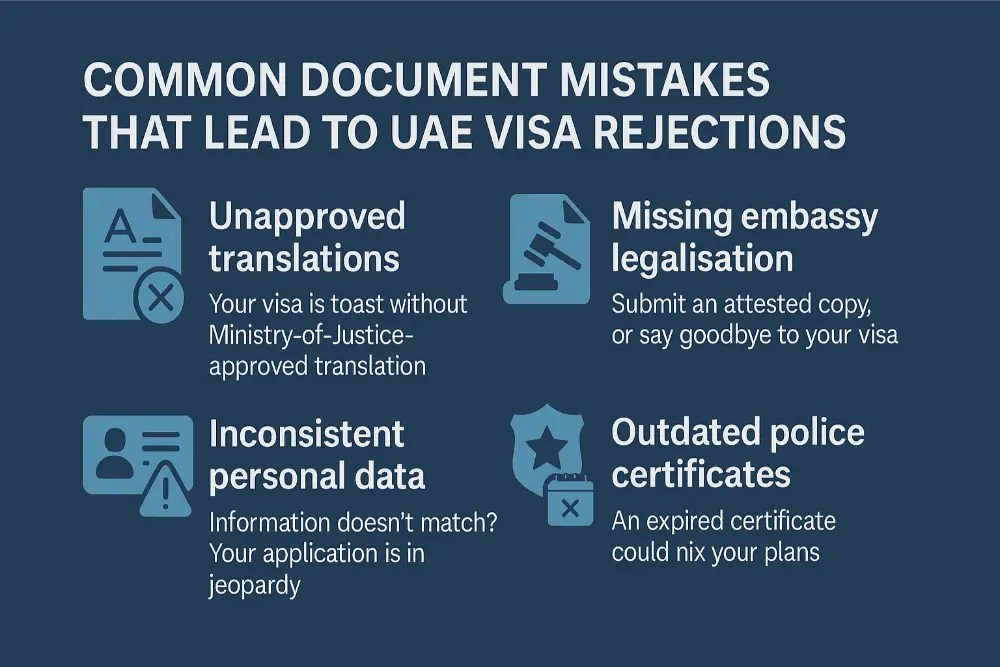
TL;DR: UAE visa rejections often happen due to outdated documents, inconsistent personal info, or unapproved translations. Staying organised and using certified translation services helps avoid costly delays.
Key Takeaways:
Sorting out your immigration documents for a UAE visa can feel more complicated than it should be.
Simple translation errors or missed embassy stamps have caused delays and outright rejections for many applicants.
Whether you’re heading to Dubai for a new job or reuniting with loved ones in Abu Dhabi, your paperwork has to be accurate from top to bottom. A single mismatch or missing stamp can put your visa on hold.
This guide walks you through the exact documents you’ll need, the key steps to follow, and what to double-check before handing anything over. A little preparation now can save you a lot of stress later.

Make sure your documents are still valid and won’t expire anytime soon.
If your passport is down to its final six months, it might raise concerns and cause delays in your visa approval. It’s one of those small details that can lead to big problems if overlooked.
In most cases, it’s not enough to just have these documents translated. They also need to be officially stamped and verified by several government departments before they’re accepted for visa processing.
For employment visas, HR departments in UAE companies usually ask for certified and attested documents like degrees, diplomas, and work experience letters. These must be correctly formatted and translated into Arabic by an authorised translator.
If you can’t locate one of these documents, such as an old diploma or an outdated reference letter, reach out to your previous employer or educational institution for a reissue or formal statement.
In some cases, an affidavit or certified declaration may be accepted as a substitute, but always confirm this with the employer or the UAE immigration authorities before submitting anything.
Many visa categories will ask for a police clearance certificate, and it’s not something you can dig out of a drawer.
The document must be newly issued, typically no older than 3 to 6 months at the time of your application.
If you’re applying from abroad or don’t have access to your home country’s clearance services, check if your local consulate or embassy can help you request one remotely or guide you through alternative options.
If you’re submitting documents for a UAE visa, a regular translation won’t cut it. UAE immigration and most embassies will only accept certified Arabic translations.
That means the translation must come from an authorised office, complete with official stamps and signatures. Without these, your application may be seen as incomplete.
Depending on the visa type, you may be required to get certain documents legalised by your home country’s embassy within the UAE.
This step is often missed, especially in family sponsorship or student visa applications, but it’s essential.
Without embassy legalisation, some of your documents could be considered invalid for processing.
Mistakes like these can easily result in your visa being delayed or denied because your paperwork is marked as incomplete.
Always double-check with the translator and the receiving authority to be safe.
For a deeper look at how poor translation quality can impact legal outcomes, even beyond immigration, this article about courtroom translation issues in Dubai is worth a read.
If your documents were issued outside the UAE, there’s a good chance they’ll need to be approved by the Ministry of Foreign Affairs before they can be used for your visa application.
This step confirms that your paperwork has been legally recognised and verified at the federal level.
Depending on the type of visa you’re applying for, you might also need your documents legalised by your home country’s embassy in the UAE.
It’s a step many applicants overlook, especially when dealing with family sponsorship or education-based applications. Without it, your documents may not be accepted.
Most applications in the UAE go through typing centres that handle data entry for visa forms. While they’re generally reliable, errors can happen.
Even a small mistake, such as a misspelled name or the wrong birthdate, can cause unnecessary delays.
Always take a few extra minutes to review the final documents before submission.
Keep your documents grouped into a few main categories to avoid mix-ups:
Having them sorted from the beginning makes the process much easier.
Before submission, take time to confirm that every detail is consistent:
Even a small error can cause delays or rejections.
Don’t risk delays over unaccepted translations:
This way, your translations won’t be questioned or rejected during processing.
If you’re unsure what qualifies as a certified translation or why it’s required in the first place, this article offers a helpful breakdown.

Vision Translation is not just another translation company. We’re authorised by the UAE Ministry of Justice, and our work is recognised by embassies, MOFA, and immigration offices throughout the Emirates.
With over 15 years in the business, we know the exact specifications required for over 50 countries’ document submissions. No guessing, no trial-and-error.
All translations are handled by native Arabic speakers with legal expertise. That means fewer revisions and higher acceptance rates. Learn more about our full range of certified translation services here.
Need it today? We offer same-day service for urgent visa needs without sacrificing quality.
We’re conveniently located in Dubai, Abu Dhabi, and Sharjah, with remote document submission options available.
Contact us now to get a quote or walk in to one of our UAE offices.
